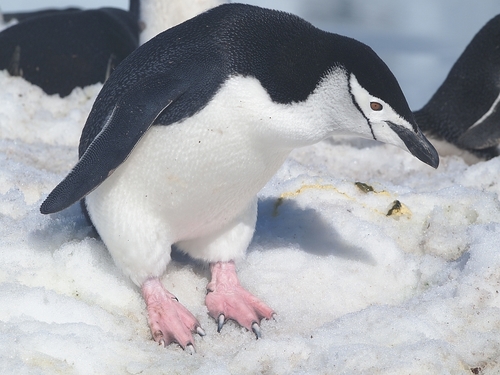
Chinstrap Penguin
The Chinstrap Penguin (*Pygoscelis antarcticus*) is a distinctive penguin species easily recognized by the narrow black band under its chin, resembling a helmet strap. These penguins play a crucial role in the Antarctic marine ecosystem as both predator and prey. They are known for their large breeding colonies, often numbering in the millions, and their remarkable resilience in harsh environments. Culturally, they are an iconic symbol of Antarctica, representing the unique wildlife found in this remote region.
68-76 cm
Length
Not applicable (wings modified into flippers) cm
Wingspan
Least Concern
Conservation Status
Distribution
Chinstrap Penguins are found in the Antarctic Peninsula, South Sandwich Islands, South Orkney Islands, South Shetland Islands, South Georgia, Bouvet Island, and Balleny Islands. They have a circumpolar distribution and undertake extensive migrations outside of the breeding season.
Lifespan
Average 15-20 years in the wild.
Chinstrap Penguin's Habitat
Habitat Types
Ice-free coastal areas, Rocky islands, Icebergs
Climate Zones
Antarctic, Subantarctic
Adaptations
Chinstrap Penguins have dense, waterproof feathers for insulation in frigid waters. They also possess strong claws for gripping ice and rocks, and countershading (dark back, light front) helps camouflage them in the water from predators above and below.
Variations
No recognized subspecies exist, though there may be minor genetic variations between different colonies.
Appearance
Breeding Plumage
Plumage remains similar year-round, though it may appear duller after molting.
Seasonal Feather Changes
Annual molt occurs after breeding, replacing old, worn feathers.
Sex Based Plumage Differences
Minimal visual differences between sexes.
Notable Features
Distinctive thin black band across the chin., Black back and white belly., Pinkish feet with strong claws.
Diet and Feeding
Primary Foods
Krill, Small fish, Squid
Foraging Behavior
Chinstrap Penguins are pursuit divers, diving to depths of up to 70 meters to catch prey. They often forage in large groups.
Specializations
Their streamlined bodies and powerful flippers enable efficient underwater pursuit of prey.
Seasonal Diet Variations
Diet composition can vary depending on prey availability, which fluctuates with oceanographic conditions and season.
Behavior
Social Structure
Highly social; forms large breeding colonies, often numbering in the millions.
Communication
Loud, harsh calls, Braying sounds, Visual displays (head and flipper movements)
Migration
Chinstrap Penguins migrate northwards during the non-breeding season, following the receding ice edge.
Territorial or Group Behaviors
Highly territorial within breeding colonies, defending their nest site aggressively. Outside of breeding season, they are less territorial and often form large rafts at sea.
Conservation
Threats
Climate change (affecting sea ice and krill availability), Overfishing of krill, Oil spills, Human disturbance at breeding colonies
Protection Programs
Antarctic Treaty System, Commission for the Conservation of Antarctic Marine Living Resources (CCAMLR)
Local National Laws
Protected under various national laws within the Antarctic Treaty System.
Population Trend
Stable
Population Estimates
Estimated at around 8 million breeding pairs.
Interesting Facts
Chinstrap Penguins are among the most abundant penguin species in the world.
Their large population size reflects their adaptability to the Antarctic environment.
They can travel up to 80 kilometers (50 miles) offshore to forage for food.
This demonstrates their remarkable swimming and diving abilities.
They are known for their 'porpoising' behavior.
Leaping out of the water while swimming helps them breathe and avoid predators.
Faqs about Chinstrap Penguin
What is the main predator of Chinstrap Penguins?
Leopard seals and killer whales are significant predators of Chinstrap Penguins, especially in the water. Skuas and giant petrels prey on eggs and chicks.
How deep can Chinstrap Penguins dive?
They can dive up to 70 meters (230 feet), although most dives are shallower.
Are Chinstrap Penguins aggressive?
They can be very aggressive when defending their nests and territories within the breeding colony.
Do both parents raise the chicks?
Yes, both parents share the responsibilities of incubating the eggs and feeding the chicks.
Copyright @ Nature Style Limited. All Rights Reserved.
 English
English